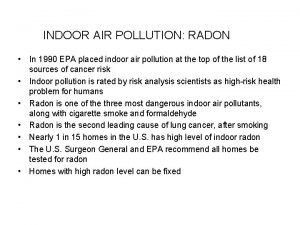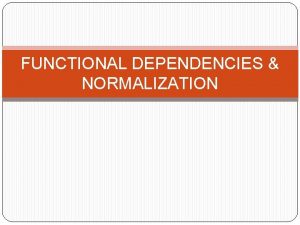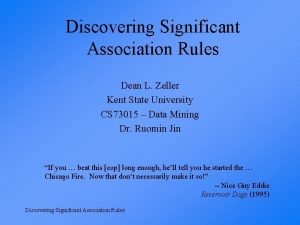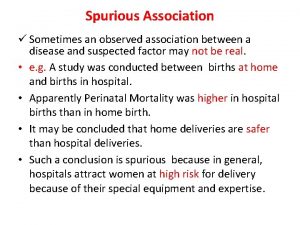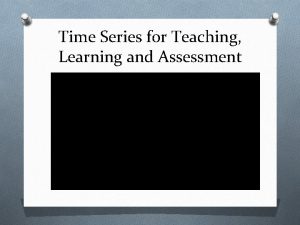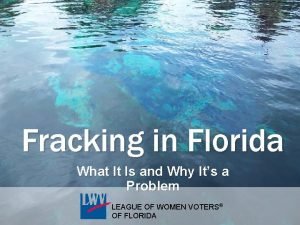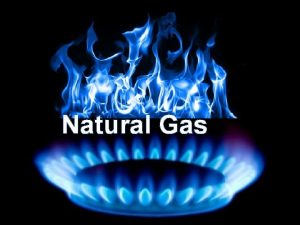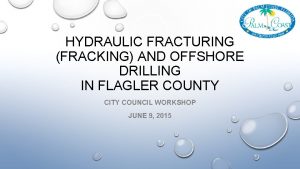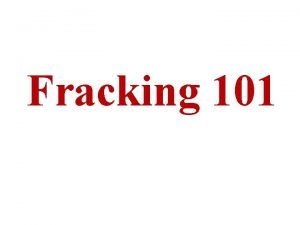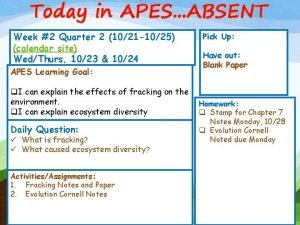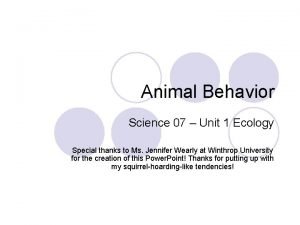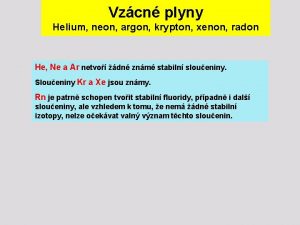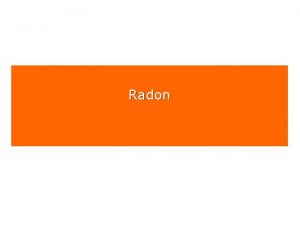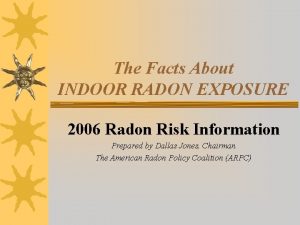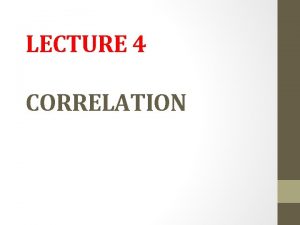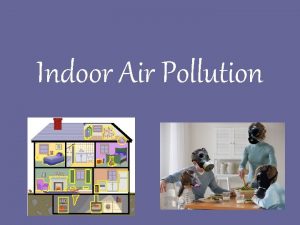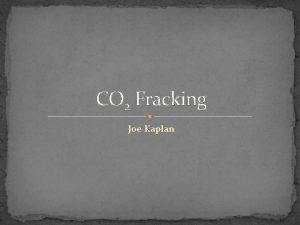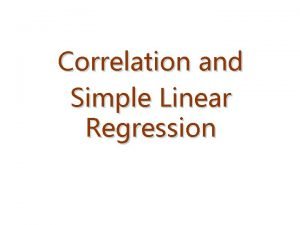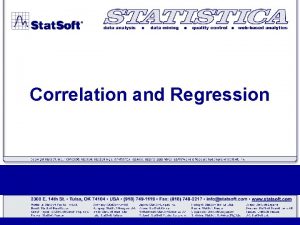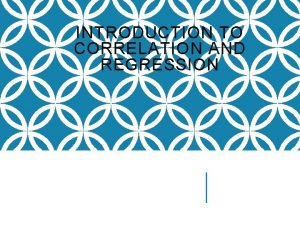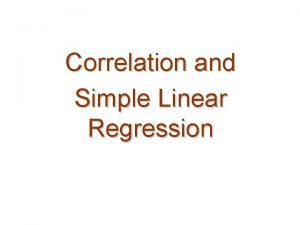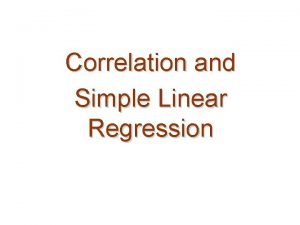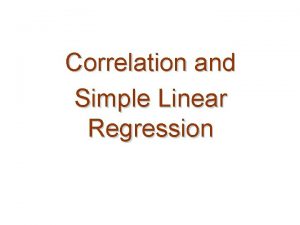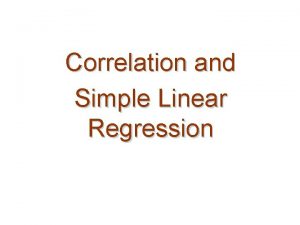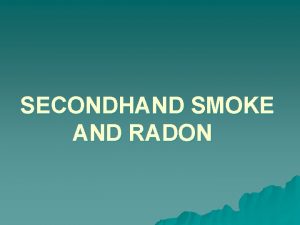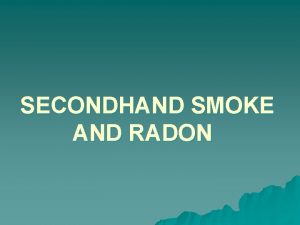FRACKING AND INDOOR RADON SPURIOUS CORRELATION OR CAUSE



















- Slides: 19

FRACKING AND INDOOR RADON: SPURIOUS CORRELATION OR CAUSE FOR CONCERN? Katie Jo Black, Shawn J Mc. Coy, & Jeremy G Weber Kenyon College blackk@kenyon. edu

Motivation Fracking Radon Methodology Naïve Model Well Siting Correlation Dynamic Model Descriptive Stats Results Conclusions

Motivation Fracking is a controversial practice Health Concerns Impact on infants [Mc. Kenzie et. al. , 2014; Casey et. al. , 2016; Currie et. al. , 2017; Hill, 2018] Asthma [Rasmussen et. al. , 2016] Cancer [Finkel, 2016; Mitchell et. al. , 2016] Hospital Utilization [Jemielita et. al. , 2015] Environmental Impact Water Quality [Olmstead et. al. , 2013; Hill and Ma, 2017] Wastewater [Tasker et. al. , 2018]

Motivation Radon PA has areas with high levels of radon Radon is a carcinogen and known to cause lung cancer [EPA] Fracking PA has vaulted into a prominent energy producer since 2005 Unconventional drilling has large negative externalities

Fracking Note: Unconventional horizontal wells drilled per sq km up to 2010

Fracking Note: Unconventional horizontal wells drilled per sq km between 2010 to 2016

Our Paper Does an increase in fracking activity cause an increase in indoor radon levels? • Previous studies linking health to fracking lack methodological rigor (Werner et. al. , 2015) • Radon provides an ideal quasi-experimental environment • Well documented correlation in previous studies • Mandated reports if parcels test • Treatment varies on three fronts • Continuity (number of wells) • Intensity (distance to wells) • Duration (age of the well)

Descriptive Statistics - Spatial Distance Interval Test Occurred After Drilling 0 -2 km 2 -4 km 4 -6 km 6 -8 km 8 -10 km 10 -12 km 12 -14 km 14 -16 km 16 -18 km 18 -20 km Mean ln(reading) (N) Test Occurred Before Drilling Mean ln(reading) 1. 37 1. 30 1. 29 1. 27 1. 25 1. 23 1. 21 7, 706 21, 138 32, 932 46, 808 61, 018 76, 401 87, 682 102, 894 118, 144 129, 178 1. 37 1. 26 1. 25 1. 24 1. 23 1. 21 1. 20 (N) 20, 039 54, 045 82, 272 113, 746 143, 865 170, 507 190, 455 219, 124 250, 395 266, 762 Note: In columns 2 and 3, the number of radon tests in a given row includes all tests with at least one well in the corresponding distance interval (e. g. 0 -2 km), and the test occurred after it was drilled. In columns 4 and 5, all tests had at least one well in the corresponding interval, but the test occurred before drilling.

Descriptive Statistics - Temporal Period Mean ln(reading) Readings (N) >48 mo Prior 1. 34 12, 584 42 -48 mo Prior 36 -42 mo Prior 30 -36 mo Prior 24 -30 mo Prior 18 -24 mo Prior 12 -18 mo Prior 6 -12 mo Prior 0 -6 mo After 6 -12 mo After 12 -18 mo After 18 -24 mo After 24 -30 mo After 30 -36 mo After 36 -42 mo After 42 -48 mo After >48 mo After 1. 36 1. 33 1. 38 1. 35 1. 41 1. 43 1. 41 1. 35 1. 38 1. 40 1. 39 1. 40 1. 41 1. 32 1. 33 1. 32 1, 680 1, 781 1, 908 1, 859 1, 845 1, 894 1, 922 1, 848 1, 815 1, 667 1, 557 1, 561 1, 403 1, 283 1, 184 991 1, 648

Methodology – Naïve Model

Methodology – Well Siting Correlation Model

Methodology – Dynamic Model

Results Model Variable Estimate St. Err Naïve Model 0. 009 0. 003 Well Site Correlation 0. 001 0. 003 Dynamic Approach -0. 005 0. 014 Note: Estimates are based on the models described in previous slides. We report robust standard errors clustered by county-year. The estimate for the dynamic model is the difference between the period 1 coefficient (when the test occurred in the six months after the well was drilled) and the period 0 coefficient (the test occurred in the six months before the well was drilled), with the standard error for the difference reported.

Results – Naïve Model 2 km

Results – Well Siting Correlation 2 km Interval

Results – Dynamic 2 km Interval

• Traditional diff-in-diff techniques work exceptionally well for clearly defined treatments and if we don’t expect the treatment effect to diminish over time. • Our approach accounts for the non-linearity of the treatment effect. • The number of wells may have different impacts • Older wells don’t have the same effect as new ones • The effect of wells can vary with respect to distance

• Without accounting for well-siting correlation we find a 0. 1% increase in radon levels for homes within 2 km of a fracked well. • After accounting for the spurious correlation, our results suggest no causal effect on radon levels from unconventional drilling.

Questions Katie Jo Black 311 Ascension Hall Kenyon College blackk@kenyon. edu www. katiejoblack. com @Katie. Jo. Black. Ph. D
 Radon indoor air pollution
Radon indoor air pollution Positive and negative correlation
Positive and negative correlation Spurious tuples meaning
Spurious tuples meaning Association rules formula
Association rules formula Spurious association in epidemiology
Spurious association in epidemiology Spurious correlations
Spurious correlations Pros and cons of wind farms
Pros and cons of wind farms Positive correlation versus negative correlation
Positive correlation versus negative correlation Fracking explained
Fracking explained Fracking
Fracking Fracking natural gas
Fracking natural gas Offshore drilling
Offshore drilling Fracking 101
Fracking 101 Fracking apes
Fracking apes Ter thin client
Ter thin client Proximate cause and ultimate cause
Proximate cause and ultimate cause Proximate causation vs ultimate causation
Proximate causation vs ultimate causation Learned behavior biology
Learned behavior biology Neon xenon argon
Neon xenon argon Sinogramma
Sinogramma
